International Journal of Image, Graphics and Signal Processing @ijigsp
Статьи журнала - International Journal of Image, Graphics and Signal Processing
Все статьи: 1157
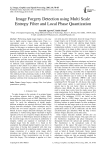
Image Forgery Detection using Multi Scale Entropy Filter and Local Phase Quantization
Статья научная
Performing digital image forgery is very easy due to highly precise image editing tools. There is a concomitant need to have some mechanism to differentiate between a forged image and the original image. In this paper, we propose a passive image forgery detection method that uses entropy filter and local phase quantization (LPQ) texture operator. The entropy filter generally highlights the boundary of the forged regions. It is due to the fact that the entropy filter provides the randomness of a pixel in its local neighborhood. The LPQ operator provides internal statistics of the image based on the phase information. We apply entropy filter on different sized neighborhoods followed by LPQ operator on the CASIA v1.0, CASIA v2.0 and Columbia image forgery evaluation databases. We consider these databases in our experiments because these are standard databases and have been used in most of the methods. Our method provides promising results on both CASIA databases; however, they are comparable on Columbia database with that of the existing state of the art methods.
Бесплатно
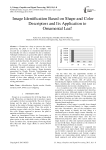
Image Identification Based on Shape and Color Descriptors and Its Application to Ornamental Leaf
Статья научная
Human has a duty to preserve the nature, preserving the plant is one of the examples. This research has an emphasis on ornamental plant that has functionality not only as ornament but also as medicine. Although in Indonesia, in general this plant is cultivated in front of the house; only few people know about its medicinal function. Considering this easiness to obtain and its medicinal function, this plant has to be an initial treatment or option towards full chemical-based medicines. This research proposes a system which able to identify properly ornamental plant from its leaf utilizing its shape or color features. Shape descriptor represented by Dyadic Wavelet Transformation and Zernike Complex Moment, and HSV-based color histogram as color descriptor. This research provides benefit of these three methods to solve various test aspects. It was obtained 81.77% of overall average-testing performance.
Бесплатно
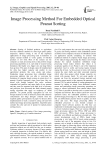
Image Processing Method For Embedded Optical Peanut Sorting
Статья научная
Sorting of finished products or agriculture food has different method for ultra high speed quality inspection. Optical sorting is one of the important applications of image processing used in industries to replace manual method to verify quality of finished products or row food. Most of the systems use the computer as main processing device that perform image processing algorithms on it, such kind of system having limitations like higher cost, bigger size and large Initial boot-up time. This type of design cannot be implemented for ultra fast, higher capacity and smaller in size agricultural products like nuts, grains and pulses. Standalone image processing have embedded image processing platform that can able to overcome the limitation of computer based systems at certain level. As peanuts (Arachis hypogeal) come from farm, they are mixed with foreign material like rocks, moisture contended soil particles and outer shells of raw peanuts and they must be separated with high level of accuracy and precision. here discussed the multi channel peanut sorting algorithm that apply on raspberry pi ARM platform for peanut quality segregation by sort out foreign material as well as defective peanut like aflatoxin contaminants and fungi allergies contents from the required quality good peanuts. In paper we discuss about implementation of such a system by using conveyor belt method and image processing algorithm. Algorithm takes consider the color and size of peanut for optical peanut sorting process.
Бесплатно
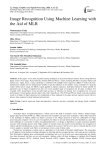
Image Recognition Using Machine Learning with the Aid of MLR
Статья научная
In this paper, we use three machine learning techniques: Linear Discriminant Analysis (LDA) along different Eigen vectors of an image, Fuzzy Inference System (FIS) and Fuzzy c-mean clustering (FCM) to recognize objects and human face. Again, Fuzzy c-mean clustering is combined with multiple linear regression (MLR) to reduce the four-dimensional variable into two dimensional variables to get the influence of all variables on the scatterplot. To keep the outlier within narrow range, the MLR is again applied in logistic regression. Individual method is found suitable for particular type of object recognition but does not reveal standard range of recognition for all types of objects. For example, LDA along Eigen vector provides high accuracy of detection for human face recognition but very poor performance is found against discrete objects like chair, butterfly etc. The FCM and FIS are found to provide moderate result in all kinds of object detection but combination of three methods of the paper provide expected result with low process time compared to deep leaning neural network.
Бесплатно
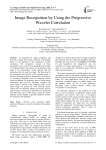
Image Recognition by Using the Progressive Wavelet Correlation
Статья научная
An algorithm for image recognition and retrieval of image from image collection is developed. Basis of the algorithm is the progressive wavelet correlation. The recognition consists of three incremental steps, each of them quadruples the number of correlation points. The process can be aborted at any stage if the intermediate results indicate that the correlation will not result in a match. The final result is the recognition and retrieval of the required image, if exists in the image collection. Instructions for the choice of correlation threshold value for obtaining desired results are defined. We perform a series of image search experiments that cover the following scenarios: the given image is present in the database; copies of the given image are present but with different names; similar (but not identical) images are present; and the given image is not present. Experiments are performed with data bases up to 1000 images, using the Oracle database and the Matlab component Database Toolbox for operations with databases.
Бесплатно
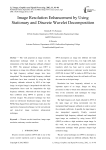
Image Resolution Enhancement by Using Stationary and Discrete Wavelet Decomposition
Статья научная
This work proposed an image resolution enhancement technique which is based on the interpolation of the high frequency subbands obtained by DWT. The proposed technique uses DWT to decompose an image into different subbands, and then the high frequency subband images have been interpolated. The interpolated high frequency subband coefficients have been corrected by using the high frequency subbands achieved by SWT of the input image. An original image is interpolated with half of the interpolation factor used for interpolation the high frequency subbands. Afterwards all these images have been combined using IDWT to generate a super resolved imaged. The proposed technique has been tested on well-known benchmark images, where their PSNR, Mean Square Error and Entropy results show the superiority of proposed technique over the conventional and state-of-art image resolution enhancement techniques.
Бесплатно
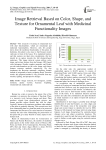
Статья научная
This research is focusing on ornamental leaf with dual functionalities, which are ornamental and medicinal functionalities. However, only few people know about the medicinal functionality of this plant. In Indonesia, this plant is also easy to find because mostly cultivates in front of the house. If its medicinal function and that easiness are taken into consideration, this leaf should be an option towards the full chemical-based medicines. This image retrieval system utilizes color, shape, and texture features from leaf images. HSV-based color histogram, Zernike complex moments, and Dyadic wavelet transformation are the color, shape, and texture features extractor methods, respectively. We also implement the Bayesian automatic weighting formula instead of assignment of static weighting factor. From the results, this proposed method is very powerful from any rotation, lighting, and perspective changes.
Бесплатно
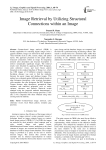
Image Retrieval by Utilizing Structural Connections within an Image
Статья научная
Content-based image retrieval (CBIR) is broadly applicable for searching digital images from a gigantic database. Images are retrieved by their primitive visual contents such as color, texture, shape, and spatial layout. The approach presented in this paper utilizes structural connections within an image by integrating textured color descriptors and structure descriptors to retrieve semantically significant images. The retrieval results were obtained by applying the HSV histogram, color coherence vector, and local binary pattern histogram to the standard database of Wang et al., which has 1000 images of 10 different semantic categories. Euclidean distance was used to find the similarity between the query image and database images. This method was evaluated against different methods based on edge histogram descriptors, color structure descriptors, color moments, the color histogram, the HSV histogram, Tamura features, edge descriptors, geometrical shape attributes, and statistical properties such as mean, variance, skewness, and kurtosis. Retrieval results obtained using the proposed methods demonstrated a significant improvement in the average precision (73.8% and 73.1%) compared with those obtained using other existing retrieval methods.
Бесплатно
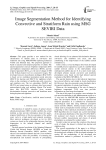
Image Segmentation Method for Identifying Convective and Stratiform Rain using MSG SEVIRI Data
Статья научная
This paper provides a new method for the classification of rainfall areas in convective and stratiform rain using MSG/SEVIRI (Spinning Enhanced Visible and Infrared) data. The proposed approach is based on spectral and temporal properties of clouds. The spectral parameters used are: brightness temperature (BT) and brightness temperature differences (BTDs), and the temporal parameter (RCT10.8) is the rate of change of (BT) in the 10.8µm channel over two consecutive images. The developed rain area classification technique (RACT-DN) is based on two multilayer perceptron neural networks (MLP-D for daytime and MLP-N for nighttime) which relies on the correlation of satellite data with convective and stratiform rain. The two algorithms (MLP-D and MLP-N) are trained using as reference data from ground meteorological radar over northern Algeria. The results show that RACT-DN classifier gives accurate discrimination between convective and stratiform areas during daytime and nighttime.
Бесплатно
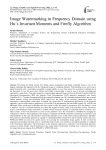
Image Watermarking in Frequency Domain using Hu's Invariant Moments and Firefly Algorithm
Статья научная
Preventing the digital content from being copied, manipulated and illegal ownership claims is one of the biggest challenges that appeared with the widespread usage of computing facilities. Watermarking is one way to tag a digital document with a watermark, perceptible or imperceptible, so as to later prove the ownership or authenticity of the document, in case the need arises. Robust and Fragile watermarking is used in case of proving ownership and authenticity, respectively. This paper proposes a watermarking approach based on Discrete Wavelet Transform (DWT), Hessenberg Decomposition (HD) and Singular Value Decomposition (SVD) approach, augmented with Firefly Algorithm (FA). To make the approach blind, the proposed technique uses Hu’s invariant moments which are invariant against rotation, scaling and translation (RST) attack over the image. In the resulting watermarked image, the watermark is imperceptible, which make it suitable for a large class of watermarking applications. In the proposed approach, a given colour image is subjected to 2 Level DWT for decomposing into sub-bands, namely LL, LH, HL and HH bands. These coefficients of HH band are fed as input for HD. The output is operated for SVD for obtain U, S and V matrices. The Hu’s invariant moments are scaled and mapped to binary string using logarithm scaling. The binary matrix, corresponding to binary watermark, is XoRed with the invariant moments, in a repeated manner, to obtain a new binary matrix, of the same dimension as count of 2X2 partitions of S. The watermark is embedded by changing the orthogonal V matrices. The magnitude of the change is computed with Firefly algorithm considering the robustness and imperceptibility as the trade-off parameters. The firefly algorithm is one of the nature inspired optimization algorithm. The proposed watermarking approach is capable of withstanding JPEG compression attack, filtering attacks and noise. PSNR and SSIM are used as the quality metric for accessing the watermarked image quality. It turns out that the proposed watermarking technique gives a considerable improvement over robustness and imperceptibility as compared to the benchmark approaches. The performance of the proposed approach as compared to the benchmark approach, increases in linear manner with the dimension of the image under consideration, reaching from 1 percent to 4 percent for image dimensions ranging from 400X400 to 1200X1200 pixels.
Бесплатно
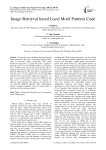
Image retrieval based local motif patterns code
Статья научная
We present a new technique for content based image retrieval by deriving a Local motif pattern (LMP) code co-occurrence matrix (LMP-CM). This paper divides the image into 2 x 2 grids. On each 2 x 2 grid two different Peano scan motif (PSM) indexes are derived, one is initiated from top left most pixel and the other is initiated from bottom right most pixel. From these two different PSM indexes, this paper derived a unique LMP code for each 2 x 2 grid, ranges from 0 to 35. Each PSM minimizes the local gradient while traversing the 2 x 2 grid. A co-occurrence matrix is derived on LMP code and Grey level co-occurrence features are derived for efficient image retrieval. This paper is an extension of our previous MMCM approach [54]. Experimental results on popular databases reveal an improvement in retrieval rate than existing methods.
Бесплатно
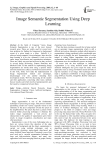
Image semantic segmentation using deep learning
Статья научная
In the fields of Computer Vision, Image Semantic Segmentation is one of the most focused research areas. These are widely used for several real-time problems for finding the foreground or background scenes of a given image or a video. Initially, it is achieved using computer vision techniques, later once the deep learning is in its rise, ultimately it took over the entire image classification and segmentation techniques. These are widely surveyed and reviewed as they are used in several Image Processing, Feature Detection and Medical Fields. All the models for implementing Image Segmentation are mostly done using a specific neural network architecture called a convolution neural network. In this work, firstly we'll study the implementation of Image Segmentation models and advantages, disadvantages over one another including their development trends. We'll be discussing all the models and their applications concerning other fancy methods that are mostly used which involves hyperparameters and the transitive comparison between them.
Бесплатно
Статья научная
We are proposing a novel algorithm for tracking human face(s) in different background video sequences. We have trained both face and non-face images which help in face(s) detection process. At first, FAST features and corner points are extracted from the detected face(s). Further, mid points are calculated from corner points. FAST features, corner points and mid points are combined together. Using the combined points, point tracker tracks face(s) in the frames of the video sequence. Standard metrics were adopted for measuring the performance of the proposed algorithm. Low resolution video sequences with challenges such as partial occlusion, changes in expression, variations in illumination and pose took part while testing the proposed algorithm. Test results clearly indicate the robustness of the proposed algorithm on all different background challenging video sequences.
Бесплатно
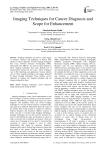
Imaging Techniques for Cancer Diagnosis and Scope for Enhancement
Статья научная
Imaging techniques are used to create images of structure, function and pathology of human body organs for cancer diagnosis. Various imaging techniques like X-ray, Ultra-Sonography (US), Positron Emission Tomography (PET), Ultrasound, MRI etc. are used for cancer diagnosis. These imaging techniques have gone through Lot of advancements during lost few years. These techniques vary in the technology and application. Various artifacts exist in these imaging techniques and images produced by theses imaging techniques. These artifacts can be exploited to enhance the imaging technique and the images produced by them.
Бесплатно
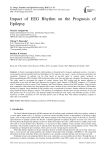
Impact of EEG Rhythm on the Prognosis of Epilepsy
Статья научная
A chronic neurological disorder called epilepsy is characterized by frequent, unplanned seizures. A seizure is an unexpected and uncontrolled electrical disturbance in the brain that can cause a variety of physical and behavioral symptoms. Prognosis of epilepsy can be done based on pre-ictal (prior to seizure) signal variations in Electroencephalogram (EEG) rhythm. EEG rhythm like alpha, beta, theta and delta are substantial for epilepsy analysis. This study aimed to investigate the impact of various features from EEG rhythm and the feature reduction in classification of pre-ictal and inter-ictal (between two seizures) signal. Dataset of CHB-MIT comprises of 23 patients with 23 channels are used to extract Time, Frequency and Time-frequency features from EEG rhythms. Analysis shows that, compared to other bands, beta band features show major variation in pre-ictal and inter-ictal phases, which makes training of a Support Vector Machine (SVM) classifier easy for prediction of seizures. Further reduction in feature size using statistical analysis helped to achieve 75% reduction in computation. Results show average sensitivity of 93% and false positive rate of 0.14 per hour. The proposed method classified pre-ictal signal with maximum accuracy of 95%, sensitivity of 100%, specificity of 93% and false positive rate of 0.07per hour with reduced complexity compare to other state of art methods.
Бесплатно
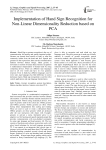
Implementation of Hand Sign Recognition for Non-Linear Dimensionality Reduction based on PCA
Статья научная
Hand Sign or gesture recognition is the way of communication for hearing and speech impaired people. Gestures are formed from motion of body or state but commonly initiate from the hand and face. Speech and gestures are the expressions; these are the communication medium between human beings. Hand gesture is movement or motion of human hand. Gesture recognition is mathematical interpretation of human hand by using computing devices. There are different sign languages used in all over world and have its own grammar structure. Even in India has different languages used in every state, sign languages has little difference in contra dictionary region. Hand sign recognition is used for robot control applications and sign language interpretation.
Бесплатно
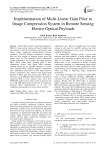
Статья научная
Future high resolution instrument planned by ISRO for space remote sensing will lead to higher data rates because of increase in resolution and dynamic range. Hence, image compression implementation becomes mandatory. Presently designed compression technique does not take account of imaging system noise like photon noise etc. This ignorance affects compression system performance. As a solution, this paper proposes MLG (Multi Linear Gain) operation prior to main compression system. With digital MLG operation, captured image can be optimally adjusted to systems noise. Proposed MLG operation improves compression ratio. Simulation results show 15-30% improvement in lossless compression ratio. However this improvement depends on MLG gains and corner points which can be driven by system SNR plot. MLG operation also helps in improving SNR at lower radiance input, when lossy JPEG2000 compression is used as main compression. Up to 1-6 dB SNR improvement is observed in simulations. Proposed MLG implementation is of very low complexity and planned to be used in future missions.
Бесплатно
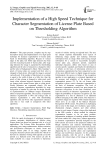
Статья научная
This paper presents, complete step by step description design and implementation of a high speed technique for character segmentation of license plate based on thresholding algorithm. Because of vertical edges in the plate, fast Sobel edge detection has been used for extracting location of license plate, after stage edge detection the image is segmented by thresholding algorithm and the color of characters is changed to white and the color of background is black. Then, boundary’s pixels of license plate are scanned and their color is changed to black pixels. Afterward the image is scanned vertically and if the number of black pixels in a column is equal to the width of plate or a little few, then the pixels of that column is changed to white pixel, until create white columns between characters, in continue we change pixels around license plate to white pixels. Finally characters are segmented cleanly. We test proposed character segmentation algorithm for stage recognition of number by code that we design. Results of experimentation on different images demonstrate ability of proposed algorithm. The accuracy of proposed character segmentation is 99% and average time of character segmentation is 15ms with thresholding algorithm code and 0.7ms only segmentation character code that is very small in comparison with other algorithms.
Бесплатно
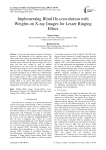
Implementing Blind De-convolution with Weights on X-ray Images for Lesser Ringing Effect
Статья научная
X-rays and other medical images are distorted because of the limitations of the Imaging system. The other source from where the distortions get in are the transmission channels. The distortions are generally noise and blur. Unless and until the medical images are free of noise and blur they cannot be used by medical professionals to the full extent for diagnosis purpose. Therefore these images must be restored properly before they are used for diagnosis purpose. There are different restoration techniques out of which one is Blind Image Deconvolution. X-ray images restored with this technique have ringing effect in them. Using edgetaper (matlab function) prior to Blind Image Deconvolution reduces the ringing effect to an extent. This paper presents Blind Deconvolution algorithm with weights which gives lesser ringing effect in X-ray images when they are restored.
Бесплатно
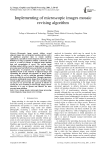
Implementing of microscopic images mosaic revising algorithm
Статья научная
Microscopic image mosaic stitches several adjacent images into an integrated seamless picture, and is of significant practical value to remote medicine applications, especially in remote diagnosis. However, due to limitation in image acquisition method, a mismatch could occur as a result of variance in adjacent image stitching data and accumulation of errors. The current image stitching method still has room for improvement regarding processing speed and effectiveness, particularly in precision. In this paper, we proposed a new image mosaic revising algorithms based on the relativity of adjacent images and expounding the principal and equations on image mosaic error revising, as well as achieving automatic intelligent calculation with the revised algorithm. Through experiment, inaccurate pathological mosaic images from 20 groups were revised rapidly and accurately with error controlled within one pixel. It was proved that the approach is effective in revising the error matching in microscopic images mosaic. Moreover, it is easy to operate and effective for more accurate image stitching.
Бесплатно

